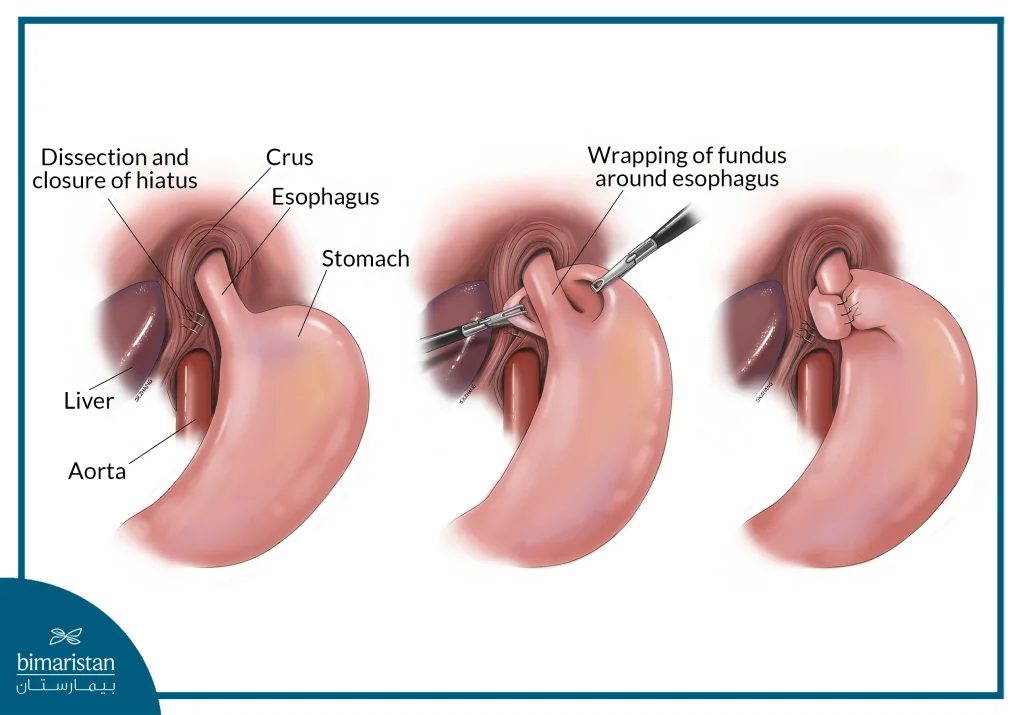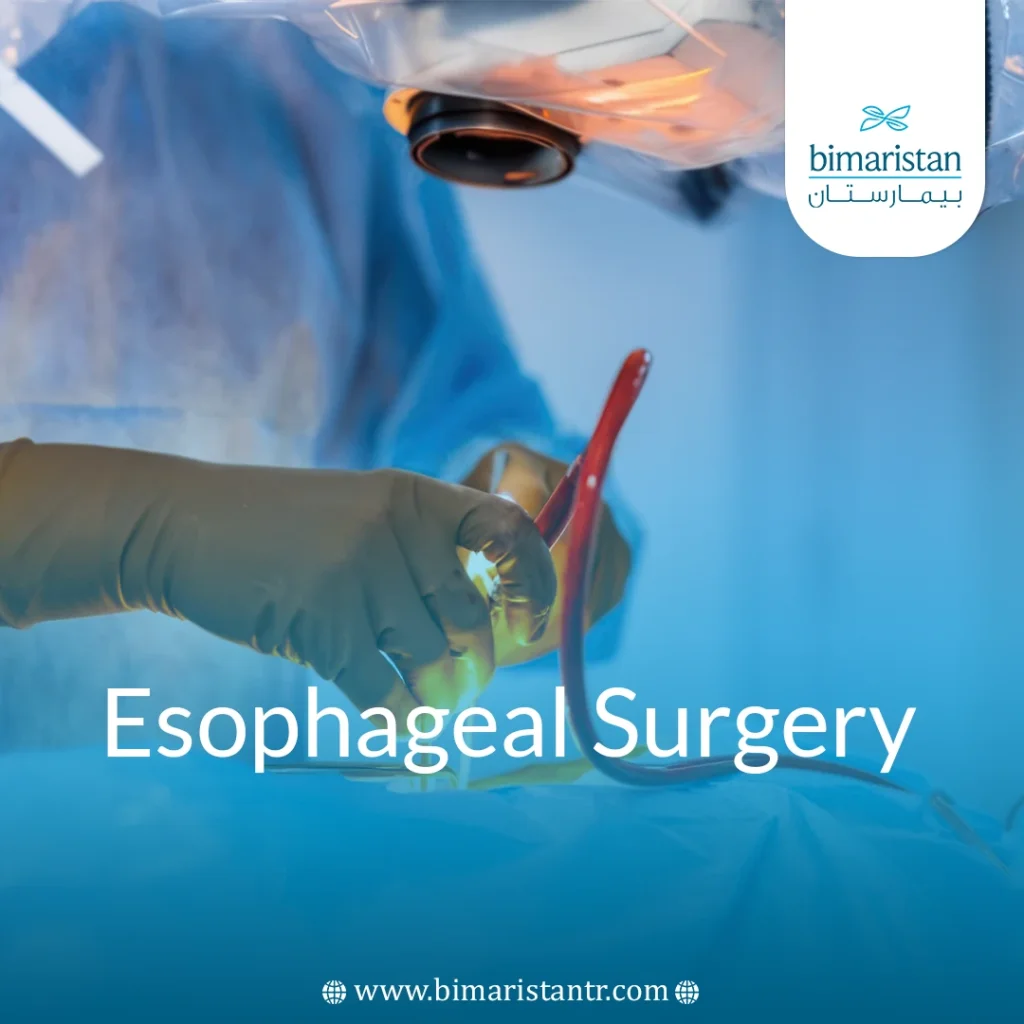Esophageal surgery is used to treat serious diseases such as severe GERD, esophageal stricture, tumors, or hiatal hernia, and is often necessary when medical treatments fail. In this article, we will learn about the types of esophageal surgery, the conditions that require it, the success rate, and the recovery period
When do you need esophageal surgery?
Although most esophageal diseases are treated pharmacologically or conservatively, some cases require surgical intervention when treatments fail or structural or cancerous complications arise:
- Failure of drug treatments for GERD
- A narrowing or blockage that prevents swallowing
- Treatment of benign or cancerous tumors
- Correcting a large diaphragmatic hernia
- Barrett’s esophagus abnormalities or bleeding from chronic ulcers that don’t respond to treatment
Types of esophageal surgery depending on the situation
Although surgery is considered the last option, there are several types of esophageal surgeries, depending on the cause and treatment needed:
Gastroesophageal reflux surgery (Nissen procedure)
The most common procedure to treat acid reflux (GERD), especially when medications have failed, involves wrapping the upper part of the stomach around the lower esophageal valve to reinforce its closure and prevent acid reflux. It is usually performed laparoscopically, which reduces pain and recovery time, and can be performed with open surgery when necessary.

Esophagectomy
It is performed in cases of large malignant or benign tumors, such as Barrett’s esophagus or esophageal cancer, and can be performed open, laparoscopically, or robotically. Complication rates range from 10-20% and mortality rates from 2-5% depending on the center and the nature of the disease, and decrease to less than 5% in advanced academic centers.
Esophageal dilation or esophagoplasty
It is used to treat stenosis caused by scarring or congenital abnormalities, where a balloon or dilator is inserted through the endoscope to expand the narrowed area without the need for major surgery, and is considered a very safe and effective procedure.
Diaphragmatic hernia repair
When a large hernia presses on the end of the esophagus and leads to persistent reflux, it is surgically repaired through the gastric banding technique, which is often performed laparoscopically to reduce the opening of the diaphragm and fix the stomach inside the abdomen, and is preferred for hernia treatment with reflux complications due to less pain and faster recovery compared to open surgery.
Preparing before esophageal surgery
Good preparation before esophageal surgery is an essential step in ensuring patient safety and the success of the procedure, as it requires careful assessment and a clear understanding of the procedures required prior to surgery.
Required examinations
Tests include chest and esophageal scans to assess anatomy and muscle function, esophagoscopy to examine the lining and detect any inflammation or tissue changes, and respiratory evaluation to see how well the lungs can withstand anesthesia and surgery, especially in patients with chronic respiratory diseases.
Pre-operative nutrition guidelines
The patient usually fasts for 6-8 hours before surgery to reduce the risk of aspiration during anesthesia, and in some cases a special diet is recommended before surgery to improve nutritional status and reduce complications.
When should blood-thinning medications be discontinued?
It is recommended to stop taking blood-thinning medications such as aspirin or warfarin 5-7 days before the procedure, as directed by your doctor, to minimize the risk of bleeding during surgery.
Esophageal surgery steps in detail
Esophageal surgery is performed with precise steps that vary according to the type of case and the use of advanced techniques to ensure patient safety and the effectiveness of the treatment.
General anesthesia
The procedure begins with general anesthesia to ensure the patient feels no pain throughout the surgery, and breathing and vital functions are carefully monitored during the procedure.
Making incisions or openings
Laparoscopic or Robotic-assisted surgery requires 3 to 5 small incisions in the abdomen instead of the large incision in traditional surgery.
Procedure duration and blood loss
The surgery usually takes between 2 and 4 hours, and blood loss is low in most cases, especially when using modern techniques.
Repair or resection procedure
The surgeon performs the required operation depending on the case, such as gastric banding in Nissen’s operation or partial/complete esophagectomy in tumor cases.
These steps are slightly different, as they depend on the type of surgery and the condition, and the doctor determines the most appropriate technique after a thorough evaluation.
After esophageal surgery: Recovery and complications
The period after esophageal surgery requires careful follow-up to ensure recovery and prevent potential complications.
Hospitalization period
The patient usually spends 5 to 7 days in the hospital, including one or two days in the intensive care unit, depending on the type of surgery. You will start eating through a feeding tube or clear liquids for the first few days and gradually switch to a soft diet as directed by your doctor.
Possible complications after surgery
- Difficulty swallowing: Temporarily common due to swelling at the connection line.
- Infection and bleeding: These are two of the most common early risks.
- Leakage at the junction of the esophagus and stomach (anastomotic leak): This is one of the most serious complications and requires treatment.
Home Recovery Tips
- A gradual diet starting with clear liquid, then soft, and then regular food
- Avoid bending or lifting heavy weights to minimize strain on the delivery line
- The importance of regular follow-up with the surgeon to check wound healing and monitor symptoms
Esophageal surgery success rates and outlook
Esophageal surgery is an excellent option for treating advanced cases, and its success rate depends on the type of issue, the health of the patient, and the experience of the medical team, which determines the exact outlook for the future.
When do the results show up?
Nissen fundoplication surgery improves symptoms in 85-90% of patients in the short term, with continued success in the medium term (⁓88% after 5 years, and ⁓73% after 10 years).
Does the patient need another surgery later on?
Approximately 10-12% of patients may require reoperation within 10 years, often when gastric band slippage occurs or symptoms persist.
Expected cases of full recovery
Acid reflux patients with good response to preoperative medications are considered to achieve complete remission, non-tumor stenosis and metabolic conditions in GERD patients also show excellent results, in esophagectomy surgery (cancerous) surgery is surgery with curative intent with survival chances ranging from 15-80% within 5 years depending on the stage, advanced centers are seeing a decrease in mortality rate to less than 5% and an improvement in these outcomes overall.
Esophageal surgery is a delicate but very effective procedure for treating chronic or complex diseases, provided you choose the right timing and a qualified medical center. If you have persistent symptoms or have not benefited from medications, surgery may be the best solution for you.
Sources:
- MedlinePlus. (n.d.). Esophagectomy. U.S. National Library of Medicine.
- National Center for Biotechnology Information. (2020). Esophageal cancer: Surgical treatment. In StatPearls. StatPearls Publishing.

